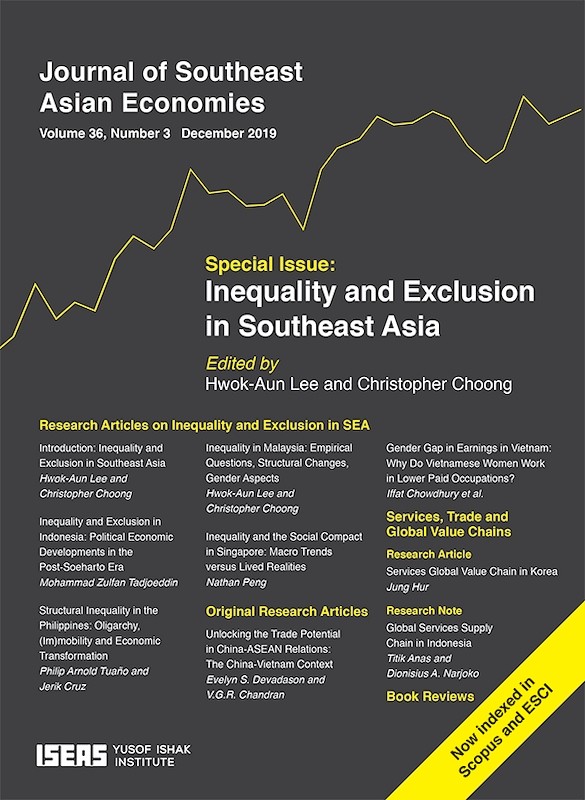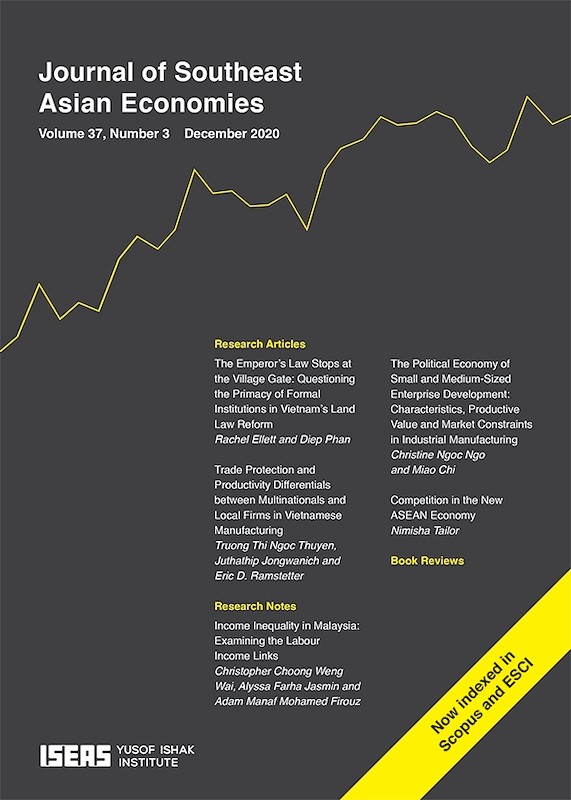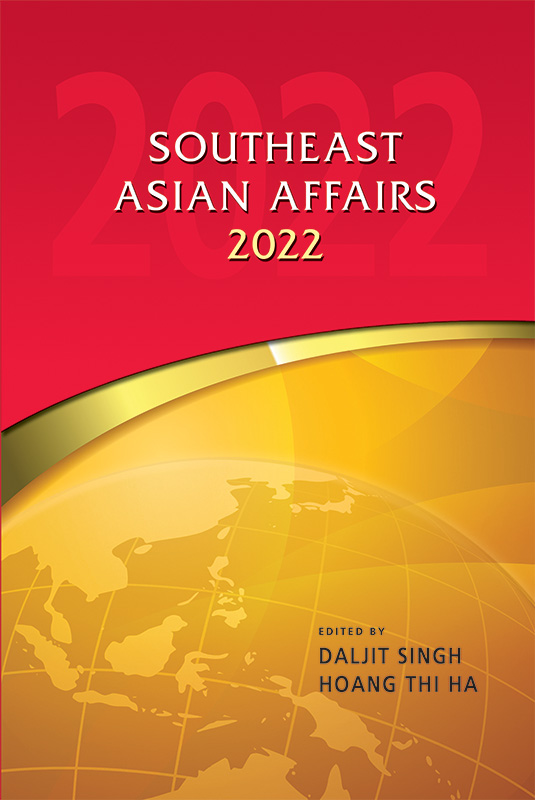Journal of Southeast Asian Economies Vol. 36/2 (Aug 2019). Special focus on "Services, Trade and Global Value Chains"

Date of publication:
August 2019
Publisher:
ISEAS – Yusof Ishak Institute
Number of pages:
140
Code:
AE36/2
Contents
-
Journal of Southeast Asian Economies Vol. 36/2 (Aug 2019). Special focus on "Services, Trade and Global Value Chains"
[Whole Publication, ISSN: 23395206] -
Preliminary pages
- RESEARCH ARTICLES
-
Introduction: Services Supply Chain—The Impact on Trade and Development in East Asian Countries, by Fukunari Kimura, Shandre M Thangavelu, Christopher Findlay, Lurong Chen, authors see abstractA well-developed services supply chain is crucial for regional integration. In the context of East Asia and ASEAN, it will allow countries at varying development stages to effectively participate in regional as well as global supply chains. This paper examines services from a supply chain perspective and discusses policy implications for liberalization of the sector in East Asian economies. In particular, the study focuses on global value chain (GVC) activities for services that are independent of linkages to the manufacturing sector.
-
2. Mapping the Philippines in the Offshoring Services Global Value Chain, by Rafaelita M. Aldaba, author see abstractThis paper aims to analyse the current position and potential for upgrading of the Philippines in the global value chain of information technology offshoring services. With its rapid growth in the last decade, the Philippines is characterized as strong in voice and is expanding in the non-voice and more complex services sectors. Applying the IT offshoring services framework introduced by the Duke Center on Globalization, Governance and Competitiveness (CGGC) GVC, the analysis shows that the industry’s upgrading strategy could pursue the following trajectories: first, upgrading from business process outsourcing (BPO) to knowledge process outsourcing (KPO) especially in medical, financial and legal services; second, expansion and upgrading within information technology outsourcing (ITO); and third, inter-sectoral upgrading to verticals or industry-specific activities, particularly shared services companies, game development, and engineering design in manufacturing. The results of the study indicate that human capital development will be critical in upgrading the Philippines in the information technology and business process management (IT-BPM) global value chain (GVC).
-
3. Global Value Chain in Services: The Case of Tourism in Japan 3. Global Value Chain in Services The Case of Tourism in Japan, by Yoko Konishi, author see abstractThis paper assesses the role of global value chains (GVCs) in services and identifies the sector’s contributions towards the expansion of the Japanese economy. Specifically, the analysis focuses on the tourism sector in Japan, which has been witnessing rapid growth in recent years. Tourism is also a highly tradeable sector that, directly or indirectly, affects various services industries like transport, retail, wholesale, restaurant, agricultural production, inter alia. In order to better understand the sector, the paper develops its GVC map and estimates the ripple effects of the inbound tourism boom on Japan’s economic development using an Input-Output (I-O) table.
-
4. India in Global Services Value Chain: The Case of IT-BPM, by Sanja Samirana Pattnayak , Alka Chadha , authors see abstractThis paper examines the development of the services sector in India in terms of the global value chain (GVC) framework. In particular, it looks at the information technology and business process management (IT-BPM) services and finds that firm characteristics such as size, age and foreign ownership are important determinants of GVC participation for IT firms. Furthermore, the study demonstrates that investment in computer and IT systems promotes forward and backward linkages by the companies. Likewise, while royalty payments for foreign technology prove to be an important factor for backward participation, that is not the case for forward participation. It is also shown that R&D expenditure does not have a positive impact on GVC participation, which suggests that Indian IT firms are currently engaged in low-end activities of the value chain, carrying out mundane tasks like coding and body-shopping. In order to upgrade to greater value-added activities, investment in new technologies and products is crucial.
-
5. Services in Thailand and Participation in Global Value Chains, by Archanun Kohpaiboon, author see abstractThis paper examines the services sector in Thailand with a focus on regional and global value chains, highlighting the case of the logistics sector. Overall, the results indicate that in Thailand, services exhibit relatively low labour productivity as compared to other sectors. The logistics sector, however, is well integrated into global value chains with links to prominent multinational firms. The findings also suggest that many opportunities lie ahead for Thai firms to move up regional and global value chains.
-
6. Global Supply Chain in Singapore’s Services Sector: Retail Value Chain and Productivity Improvements, by Shandre M Thangavelu, author see abstractThe paper examines the global production value chain in Singapore’s services sector. Specifically, it explores some of the key activities related to the retail value chain in the country. Based on the experience of other major economies, the productivity and competitiveness of the retail sector will prove to be very crucial for the future of the services sector in Singapore. Therefore, this study not only highlights the key factors that could boost the productivity of retail, but also identifies significant challenges and opportunities that lie ahead.
-
7. Trade, Structural Adjustments and Productivity Growth in Vietnam: The Shift to Services, by Nguyen Dinh Chuc, Ta Phuc Duong , authors see abstractThis paper examines the development of Vietnam’s services sector in terms of economic liberalization and global value chain (GVC) activities. In particular, the analysis focuses on the growth of e-commerce services. The study uses domestic Input-Output tables and the TiVA database to identify backward and forward linkages between the country’s services and manufacturing sectors. Apart from mapping e-commerce activities, the paper also makes key policy recommendations to improve service linkages and GVC activities in Vietnam.
- BOOK REVIEWS
-
BOOK REVIEW: Energy, Governance and Security in Thailand and Myanmar (Burma): A Critical Approach to Environmental Politics in the South, by Adam Simpson (2nd ed.), by Moe Thuzar, author
-
BOOK REVIEW: Governing Cambodia’s Forests: The International Politics of Policy Reform, by Andrew Cock, by Lee Poh Onn, author
-
BOOK REVIEW: Macroeconomic Policy for Emerging Markets: Lessons from Thailand, by Bhanupong Nidhiprabha, by Yot Amornkitvikai, author






